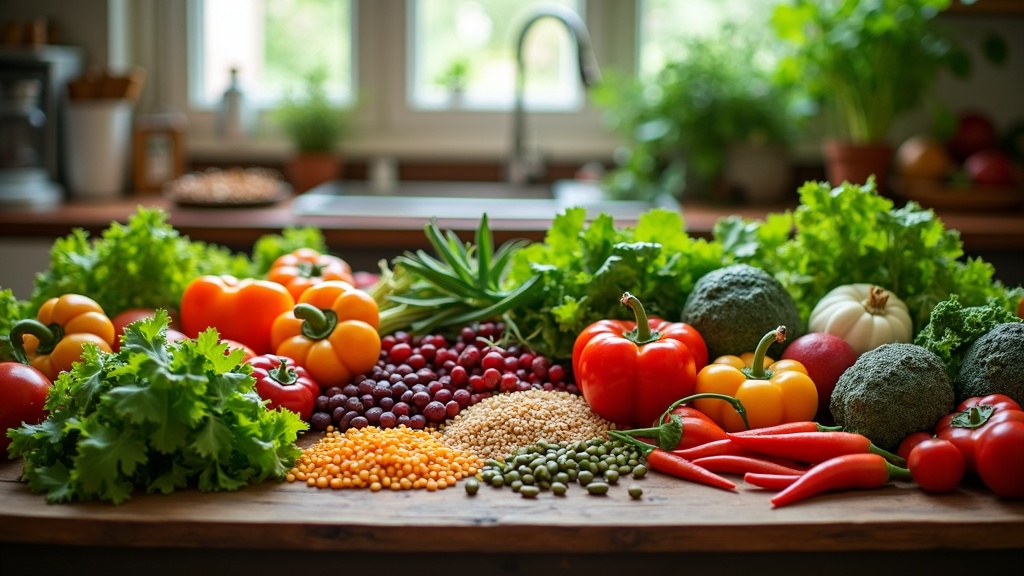Switching to a plantbased diet has been buzzing in wellness and nutrition circles, but what really catches my attention is the way this eating pattern hooks up with living longer.
While there’s no onesizefitsall fountain of youth, more and more research keeps pointing out that what’s on our plates could play a big part in how we age.
In this article, I’m sharing what I’ve learned about how plantbased eating can tie into longevity, some key nutrients to watch for, and practical tips if you’re thinking of adding more plantcentric meals to your days.

Why PlantBased Eating Is Getting So Much Attention
People have been talking about plantbased diets more in the last decade, and a lot of it is fueled by studies that suggest swapping out animalheavy meals for more plant foods could pay off in the long run.
This isn’t only about going vegan or vegetarian. For most folks, it means shifting focus—more beans, grains, nuts, veggies, and fruits; less red meat, processed foods, and fullfat dairy.
Places known as “Blue Zones,” like Okinawa in Japan and Loma Linda in California, stand out because people often live past 90 or even 100 years.
What’s interesting: their diets center around plants.
This isn’t about strict rules.
Instead, meals in these places makeup mainly whole or minimally processed plants, with meat used more as a side than a feature.
Swapping out some animal proteins for plants could mean better heart health, smoother digestion, and honestly, more energy day to day.
There’s also growing evidence that a plantbased pattern could help lower the risk of certain diseases that chip away at quality (and quantity) of life as we age.
By focusing on more beans, veggies, and whole grains, you’re setting yourself up for the long haul.
The Science: How PlantBased Diets Support Longevity
Research keeps highlighting a few key reasons why plantfocused eating seems to help with healthy aging:
- Less Chronic Disease: Plantbased diets tend to be loaded with fiber, vitamins, and phytonutrients, and come up short on saturated fat and processed bits that are linked to heart disease, diabetes, and some cancers.
- Improved Metabolism: I’ve noticed more stable energy and better digestion after eating mostly plants, and studies back this up. Fiberpacked foods help keep blood sugar balanced and digestion moving smoothly.
- Lower Inflammation: Chronic inflammation links to aging and a bunch of diseases. Plants are rich in antioxidants and compounds that seem to tame inflammation, which can keep our bodies on track as we get older.
One longterm study out of Harvard looked at over 100,000 people across decades and found those eating more plants had a lower risk of dying from heart disease and other health issues (Harvard School of Public Health).
Another review found that vegetarians and vegans show lower blood pressure and cholesterol, two super important checkboxes for aging well.
While genetics and lifestyle are definitely part of the big picture, what goes on the dinner plate stacks the odds in our favor.
To add, eating more plant foods might benefit your gut health, boosting good bacteria that supports your immune system and mental sharpness as well.
Common Types of PlantBased Diets
“Plantbased” covers a lot of ground. Here’s how a few common versions break down, so you can figure out what feels right for you:
- Vegan: No animal products at all—no meat, dairy, eggs, or honey. Everything comes from plants.
- Vegetarian: No meat, poultry or seafood, but usually includes dairy and eggs.
- Pescatarian: No meat or poultry but includes seafood, alongside plenty of plants.
- Flexitarian: Plantfocused but with occasional meat, poultry, or fish (sometimes called “semivegetarian”).
The big thing they share: all of them put veggies, fruits, grains, nuts, seeds, and legumes front and center.
Even within these, you can mix in some variety, picking a style that meshes with your lifestyle and food preferences.
Getting Started with a PlantBased Eating Pattern
Switching to a plantbased routine doesn’t have to happen overnight.
In my experience, small swaps and a curious attitude keep things fun and less stressful.
Here are some basics to get rolling:
- Start With One Meal: Try a plantbased breakfast, like overnight oats with fruit or a veggiepacked smoothie. Once that’s easy, go for a plantbased lunch or dinner. This way, you gradually introduce the new way of eating without feeling overwhelmed.
- Build Your Plate Around Plants: Fill half your plate with vegetables, then add beans, lentils, whole grains, or tofu, topping things off with seeds and herbs for a flavor boost and crunch.
- Diversify Your Pantry: Grains like quinoa, bulgur, or farro, a few canned beans, and nuts offer a base for quick meals that still hit the spot. Stocking up on different types of produce and plant proteins can make each meal unique.
- Season Boldly: Herbs, spices, citrus, and vinegar bring out tons of flavor. There’s no need for cheese or butter in every dish when you experiment with bold seasonings.
Things You’ll Want to Keep in Mind Along the Way
Switching up your eating style isn’t always a walk in the park, and there are a few challenges unique to plantbased eating.
Here’s what to watch for, plus a few quick fixes from my own kitchen adventures:
- Protein Intake: Getting enough protein is usually a concern people have. Beans, lentils, tofu, tempeh, quinoa, and nuts are all solid sources. Mixing them throughout the week helps cover your bases and keeps meals interesting.
- Key Nutrients to Track: Vitamin B12 doesn’t pop up naturally in plant foods, so I usually use a supplement or pick up fortified foods. Omega3s from chia seeds, walnuts, or algae supplements make a nice swap for fish oil. Vitamin D, iron, calcium, and zinc are also worth checking in with, especially if you’re eating strictly vegan. Rotating your food choices helps secure a wellrounded intake of vitamins and minerals.
- Social Settings and Family Meals: Attending barbecues or family holidays can feel tricky at first. I usually bring a hearty plantbased dish to share, making sure there’s something I want to eat. Sometimes, friends end up loving it, too, and it sparks conversations about tasty alternatives.
- Transitioning Palate: If you’re used to a certain taste or texture from meat or cheese, there’s a bit of a transition period. Trying out different cooking methods like roasting, grilling, or using umamirich ingredients (miso, mushrooms, smoked paprika) helps make dishes feel more satisfying. Over time, your palate starts to crave new flavors.
Protein Sources
At first, I thought skipping animal protein would mean not getting enough, but there are plenty of ways to fit it in with plants.
Black beans, lentils, tofu, tempeh, and even a chickpea salad sandwich all work well.
I often toss nuts or seeds onto salads or breakfast oats for a little boost. Edamame and hempseeds are great too—easy to add and packed with protein.
Watch Those Nutrients
Sticking to whole foods is great, but I still make a point to double check that key nutrients aren’t falling through the cracks.
A quick annual blood test with my doctor helps me keep tabs on things, especially vitamin B12 and iron.
If you’re trying new plantbased products, glance at nutrition labels for added calcium or iron, and keep an eye on your overall balance.
Being Flexible
Sometimes, the perfect plantbased meal just isn’t available, especially when I’m out with friends or traveling.
I keep it flexible and do my best, knowing that consistency matters more than any single meal.
Allowing wiggle room takes off the pressure and makes this lifestyle much more livable long term.
Tips for Making PlantBased Eating Work in Daily Life
Making any big diet switch takes reallife strategies. Here’s what helps me stick with it, without feeling restricted:
- Meal Prep Once a Week: Cooking a pot of beans, baking a tray of veggies, or making a grain bowl base in advance makes it easy to throw together lunches or dinners in minutes. Planning ahead also helps during busy weeks and reduces the urge to order takeout.
- Bookmark GoTo Recipes: Familiar favorites like chili, curry, grain salads, or veggie burgers can be tweaked with what you have on hand, so you don’t have to reinvent the wheel with every meal. Adding a few new plantbased cookbooks to your shelf can inspire creativity and help you discover flavor combinations you might not have tried before.
- Keep Healthy Snacks Handy: Hummus and veggie sticks, roasted chickpeas, or whole grain crackers help me steer clear of the vending machine. Having nutritious snacks on hand stops midday energy crashes and keeps you satisfied.
- Eat the Rainbow: Including a broad mix of colors in your daily meals means more phytonutrients, vitamins, and minerals—all working together to give your health that extra push. Try red peppers, purple cabbage, carrots, leafy greens, and berries for a nutrient boost.
Over time, eating this way becomes routine, and I genuinely start craving the fresh, vibrant flavors that show up in every meal.
Even on days when I want comfort food, I’ve learned to whip up plantbased pastas, stews, and burgers that feel every bit as satisfying as the originals.
Common Questions on PlantBased Diets and Longevity
These are some questions I’ve come across (and asked myself!) during my own adventure:
Question: Is a plantbased diet only for strict vegans?
Answer:
No, it’s about eating more plants, not about perfection. Adding more veggies, beans, and whole grains at your own pace does plenty for health.
You can still enjoy occasional animal products and make steady progress.
Question: Will a plantbased diet really help me live longer?
Answer:
While no one can guarantee extra years, many large studies tie plantrich eating patterns to healthier aging and reduced risk for diseases that can shorten lifespan.
Eating more from the garden and less from the butcher seems to move the needle toward a healthier, longer life.
Question: What about protein or important vitamins?
Answer:
With a mix of legumes, grains, nuts, and seeds, plus a few fortified foods or supplements, you can cover nutrient needs without much hassle.
Checking in with a dietitian on your transition can give you extra confidence.
Bringing It All Together
Piling more plants on your plate isn’t just about following trends; it’s a smart way to boost nutrients, lower disease risk, and, based on some really solid research, possibly help you add quality years to your life.
Familiar foods, plenty of flavors, and a practical approach to transition make sticking with it feel way less complicated.
Whether you’re doing meatless Mondays or switching things up entirely, even small steps can have a big ripple effect on health and longevity.
Wrapping up, remember that every colorful plate is a step toward feeling better, aging well, and enjoying your food along the way.
